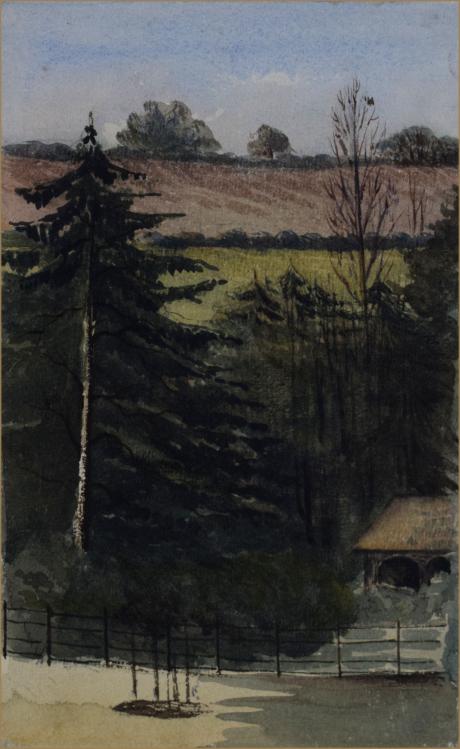inscribed in the margin " Dell Walk Turvey Cottage / Beds "
House dated 1831. Coursed limestone rubble now mainly cement rendered. Fishscale tile roof. One storey and attics. Irregular plan. E. entrance elevation has left-hand and central projecting gabled wings with bargeboards and drop finials. The left-hand wing has a 3-light attic casement with drip mould. Ground floor small bay. Central gable has similar attic window and larger ground floor bay. Between these two wings is a recessed gable with stone coping and moulded finial. Attic and ground floor 2-light casement with drip moulding. To the right of this is a small gable with first floor bay over entrance porch. The latter has a parapet and cornice with two single light and a 3-light windows with glazing bars to N. elevation. 4-centred archway in architrave surround. To the right of the porch is a gabled dormer above a conservatory which wraps around the end of the building in a semi- circle to finish under a corresponding dormer on the W. elevation. To the right of the conservatory to the W. eievation is a projecting gable with another at the S. end of the elevation. The latter has carved bargeboards and
a drop finial and moulded stone finial. Both gables have attic sash windows with drip mould. The left-hand wing has ground floor canted bay, the right- hand one French doors. Between these are two gabled dormers with a third dormer above these into the roof space. Ground floor flat-roofed porch. To the far right is a further gabled wing with a sash winoow to each floor.
Turvey is a village and civil parish on the River Great Ouse in Bedfordshire, England, about 6 miles (9.7 km) west of Bedford. The village is on the A428 road between Bedford and Northampton, close to the border with Buckinghamshire. The 2011 Census recorded the parish's population as 1,225.
Turvey is recorded in Domesday Book of 1086 as a parish in the Hundred of Willey. There are eight separate entries for Turvey, including a total of 44 households. The Mordaunt family obtained the manor by marriage in 1197 and were ennobled as Barons of Turvey in the 16th century. The Mordaunt family house, Turvey Old Hall, was replaced by Turvey House in 1792, by which time the estate had passed to the Higgins family. It was extended in the 19th century and still stands. There is a second large house in the village called Turvey Abbey, which was historically a family house, but is now a Benedictine monastery.
The Church of England parish church of All Saints has Saxon origins but is almost certainly a post-Norman building. It is the largest church in the deanery of Sharnbrook and was in the Diocese of Lincoln until it was transferred to the Diocese of Ely in 1837. Since 1914 it has been in the Diocese of St Albans. It has a 13th-century door with its original ironwork, a Norman baptismal font, a wall painting of the crucifixion and some notable monuments, including monumental brasses. The Norman church was enlarged in the 14th and 15th centuries; sumptuous improvements were made by Sir Gilbert Scott.
Turvey has a strong history of lace-making: there is evidence of a 19th-century lace-making school.
In the 19th century the Bedford to Northampton Line of the Midland Railway was built through the parish and opened in 1872. There was a Turvey railway station in Station Road about 1 mile (1.6 km) east of the centre of the village. British Railways closed the line in 1962.

